More than 8 Days
Daily Tour
50 people
___
| Semi Deluxe | ||
|---|---|---|
| ADULT | CHILD | INFANT |
| ₹48,999.00 | ₹0.00 | ₹0.00 |
| Deluxe | ||
| ADULT | CHILD | INFANT |
| ₹49,999.00 | ₹0.00 | ₹0.00 |
| Super Deluxe | ||
| ADULT | CHILD | INFANT |
| ₹56,999.00 | ₹0.00 | ₹0.00 |
| Luxury | ||
| ADULT | CHILD | INFANT |
| ₹104,999.00 | ₹0.00 | ₹0.00 |
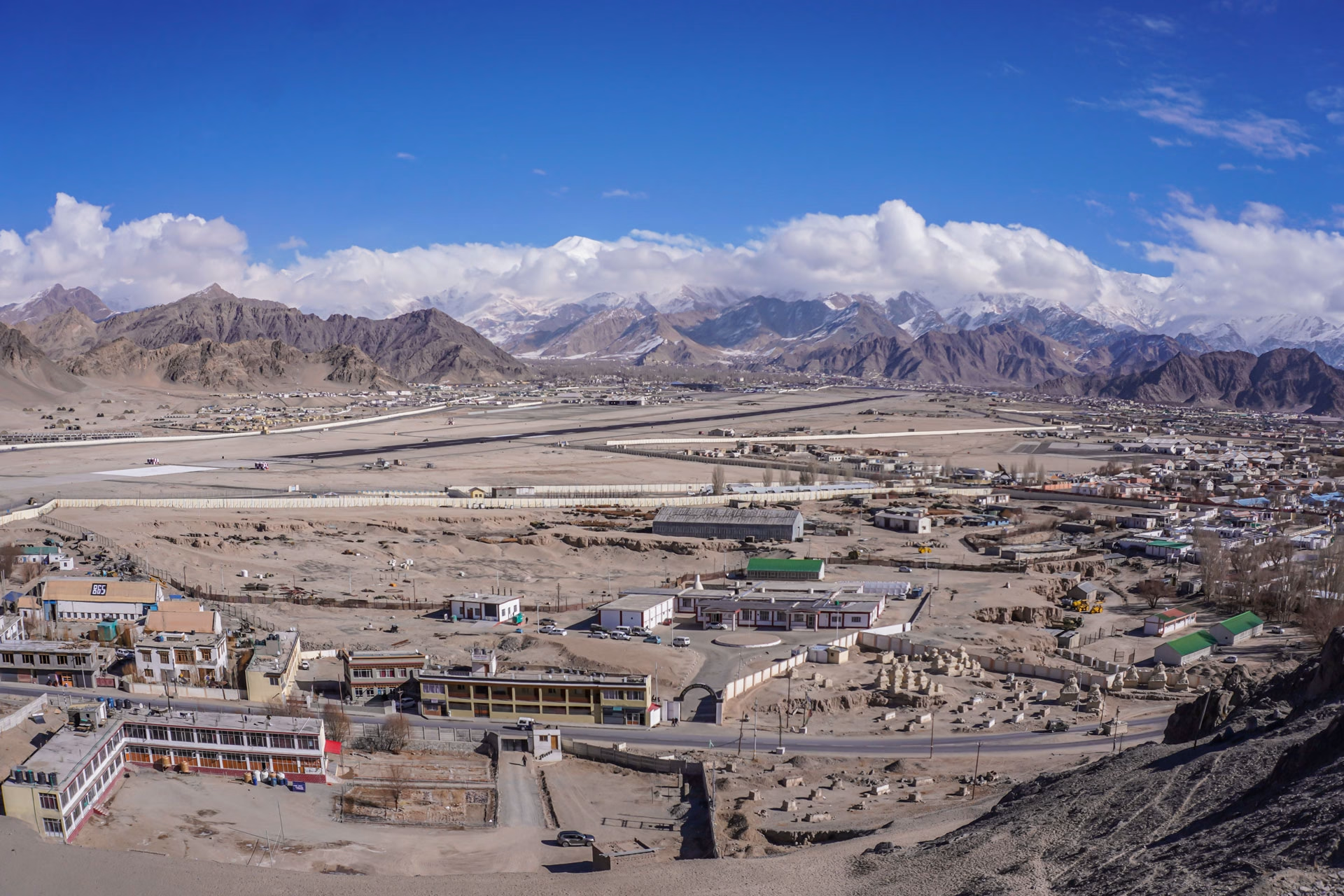
Altitude: 3500 m
We will pick you up in a cab from the airport. After that, you will check into the hotel in Leh. Spend the rest of the day resting and acclimatizing to the high altitude for a comfortable journey ahead.
Meals: Dinner Night: Stay at the hotel in Le
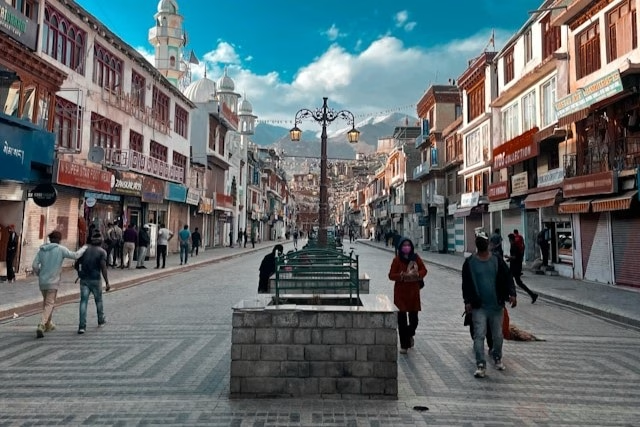
Dist: 70 km to 90 km | Altitude: 2600 m to 3500 m
After breakfast today, you will visit the Leh Palace, Santi Stupa, Hall of Fame, Spituk Monastery, Gurudwara, Magnetic Hill, Sangam, and Rafting Point. In the evening, you will return to the hotel.
Meals: Breakfast, Dinner Night: Stay at the hotel in Leh
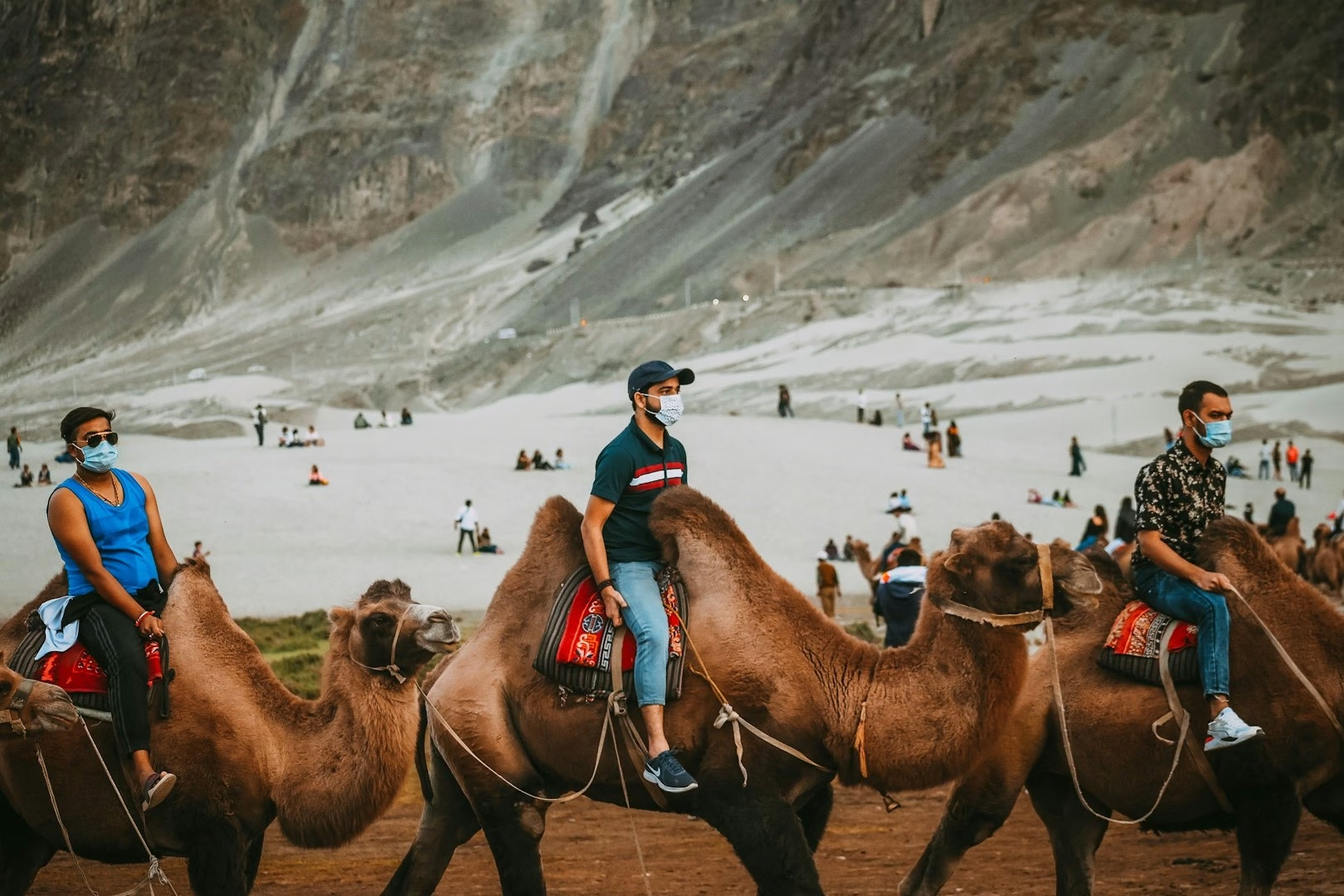
Dist: 160 km | Altitude: 3500 m to 5354 m to 3048 m
Today, you will head towards Nubra Valley via one of the Highest Motorable passes, Khardung La. You will visit Diskit Monastery, Hunder Village, Sandunes, and Camel Ride Point. Later, you will check into your stay at Nubra Valley. Meals: Breakfast, Dinner Night: Stay at a hotel/homestay in Nubra Valley
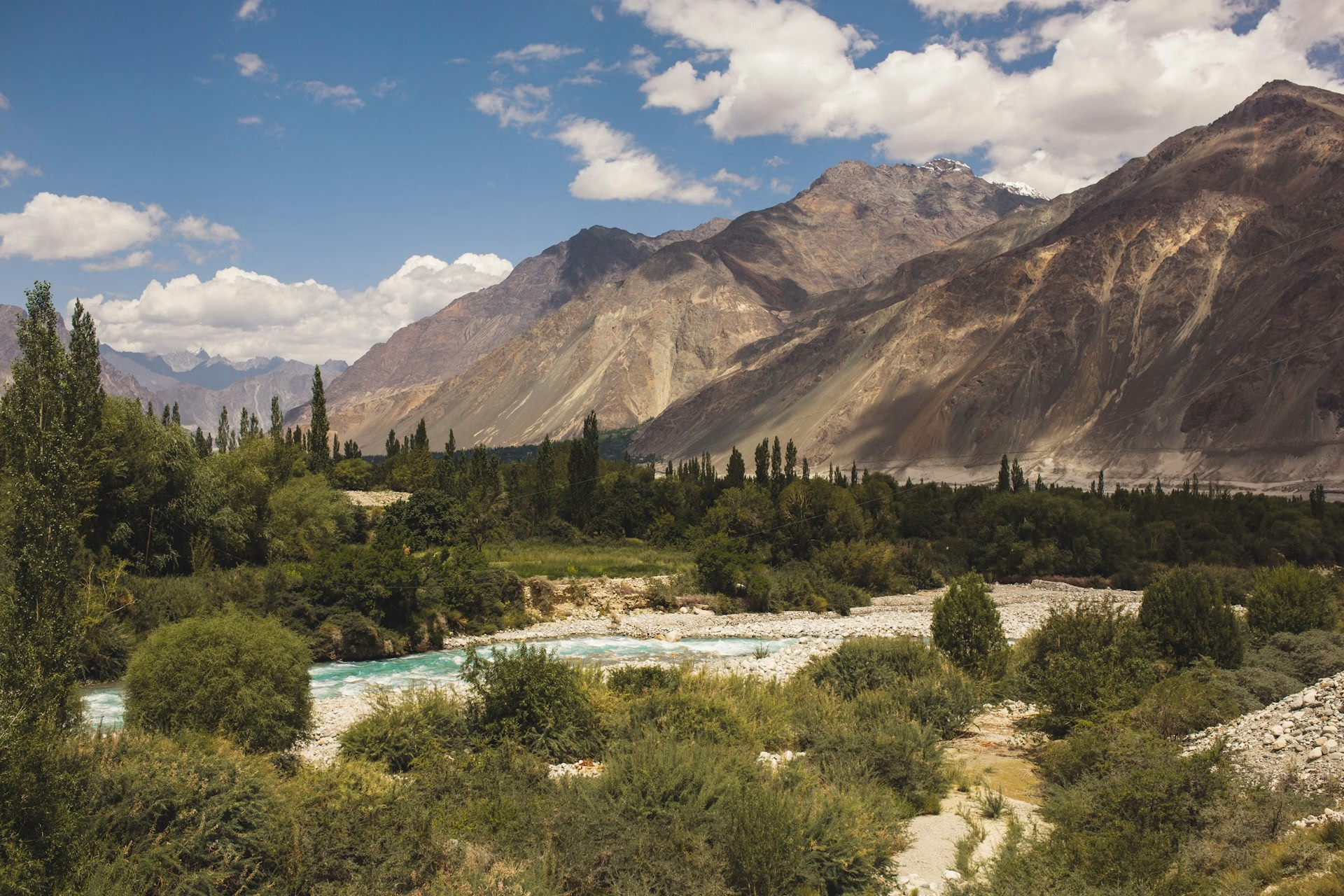
Dist: 160 km (to and fro) | Altitude: 3048 m to 3001 m
Today, you will visit the last northernmost village in India, Turtuk, a beautiful place surrounded by apricot orchards. Turtuk is known for its warm Balti culture and friendly locals. Once part of Baltistan, it became a part of India after the 1971 war. The village offers stunning views of the Shyok and the Karakoram mountains.
Meals: Breakfast, Dinner Night: Stay at a hotel/homestay in Nubra Valley
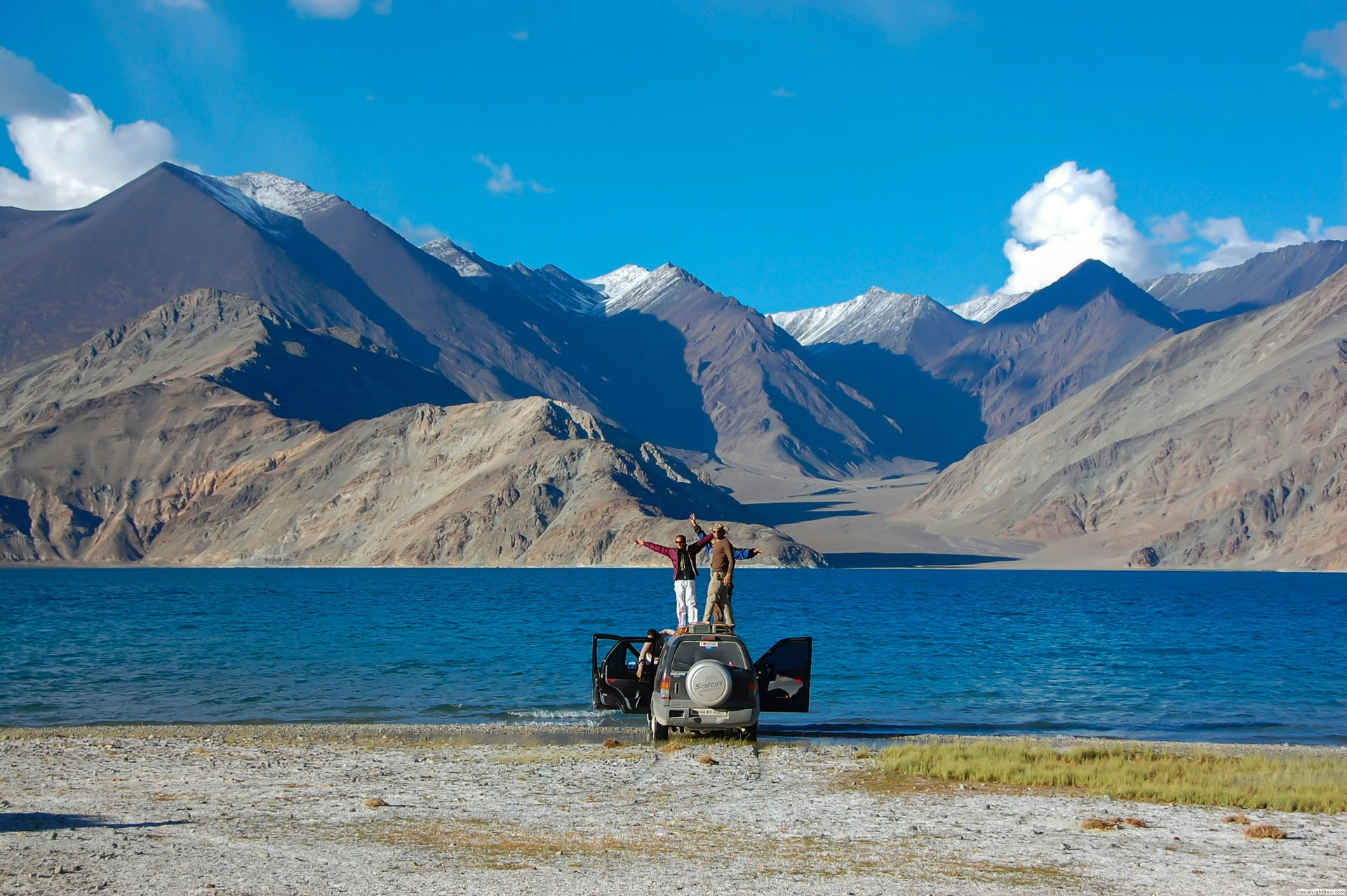
Dist: 200 km | Altitude: 3100 m to 4814 m
Today, after waking up to the view of the Karakoram ranges, you will head towards a high-altitude saline Lake called Pangong Tso via Shayok Village, Durbuk Village, Tangsay Village, and Changla Pass. At night, you will stay near Pangong Lake.
Meals: Breakfast, Dinner Night: Stay at the cottage/camps in Pangong Tso
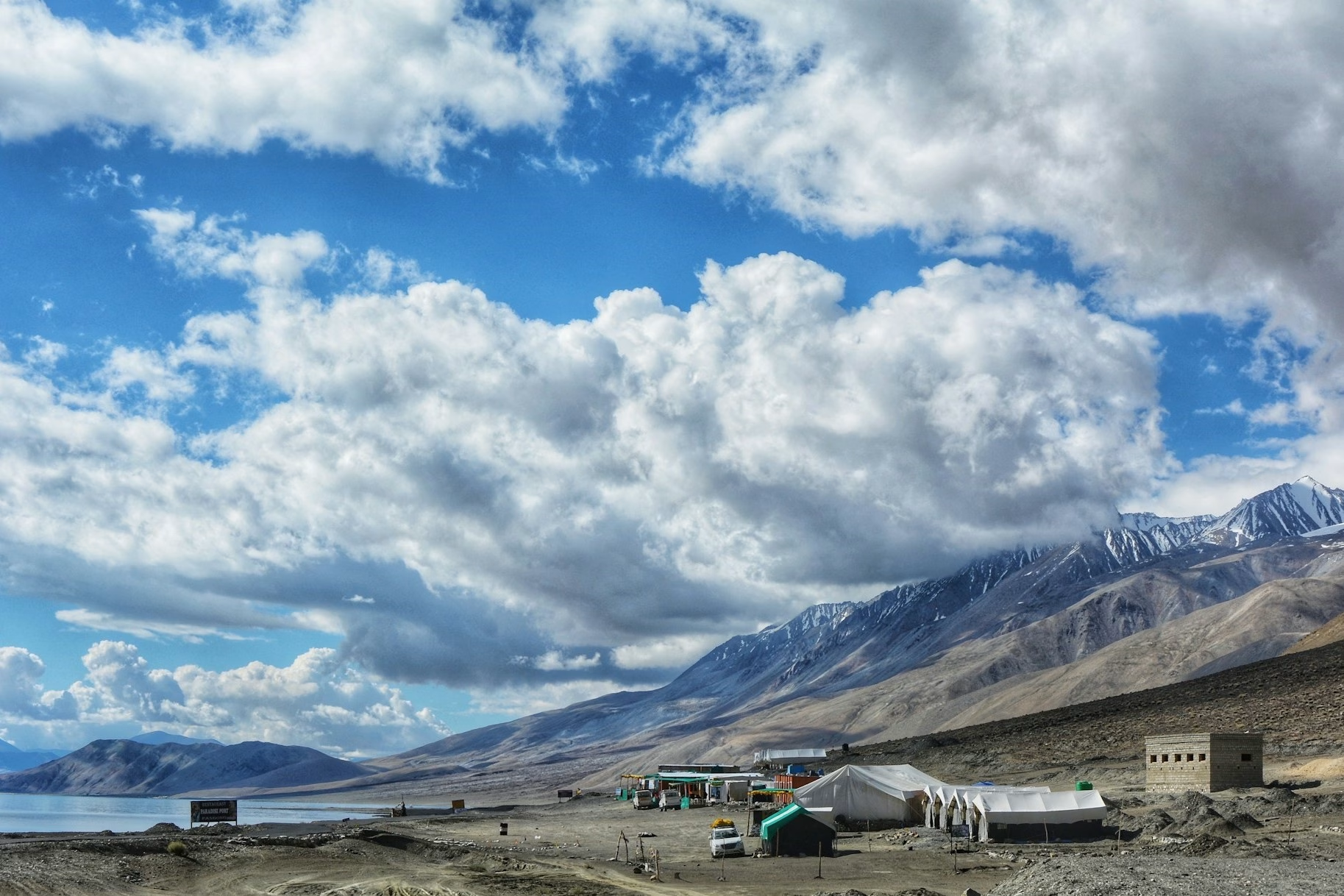
Dist: 217 km | Altitude: 3215 m to 4522 m
After having a healthy breakfast in the morning, on the way from Pangong to Tso Moriri via Saga La. You will drive along the picturesque valley of the Changthang Plateau with its snow-capped mountains and crystal-clear lakes. Later, you will check into your stay at Tso Moriri.
Meals: Breakfast, Dinner Night: Stay at camp in Tso Moriri
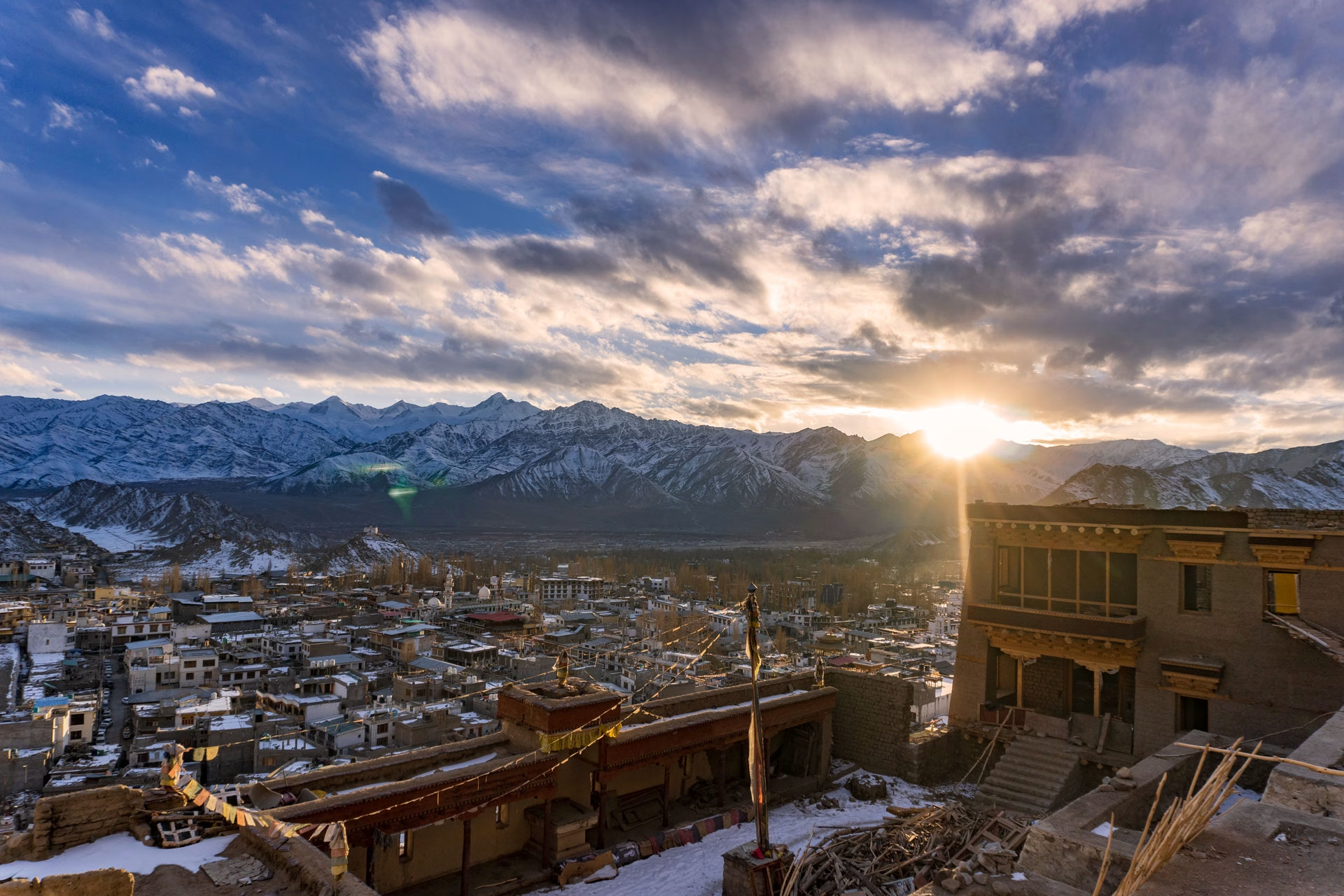
Dist: 220 km | Altitude: 4522 m to 3500 m
Today, wake up to a beautiful morning in the Tso Moriri; along the way, you will visit TsoKar Lake, Puga Hot Spring, Puga Village, Tanglangla Pass, Thiksey Monastery, Rancho School, and Shey Palace. In the evening, return to the hotel. Meals: Breakfast, Dinner Night: Stay at the hotel in Leh
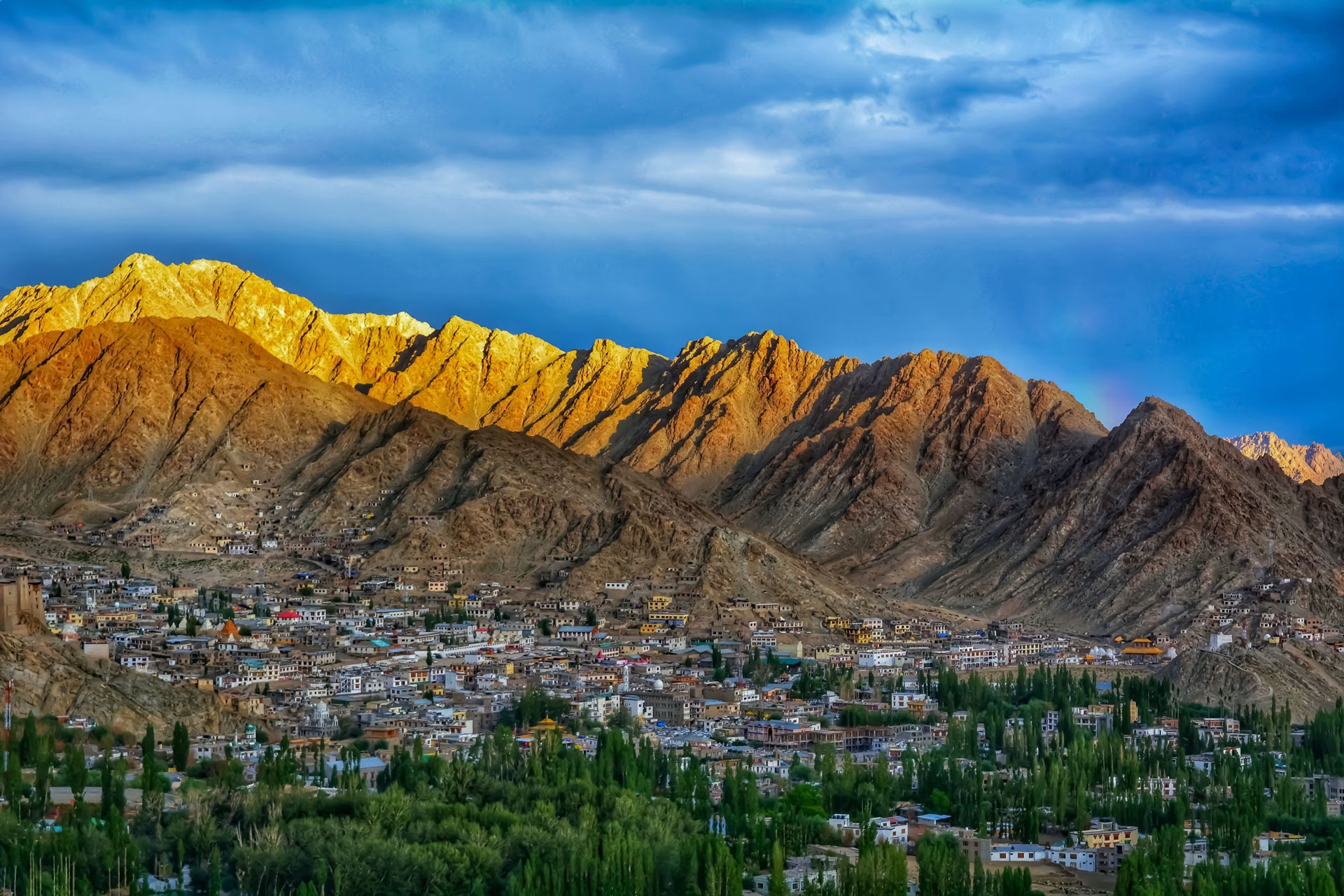
Dist: 210 km | Altitude: 3500m to 4088 m to 2757 m
After breakfast, you will move towards Kargil. En route, you will visit the Hall of Fame, Spituk Monastery, Gurudwara, Magnetic Hill, Sangam, and Rafting Point. In the evening, you will check into your accommodation at Kargil. Meals: Breakfast, Dinner Night: Stay at the hotel in Kargil
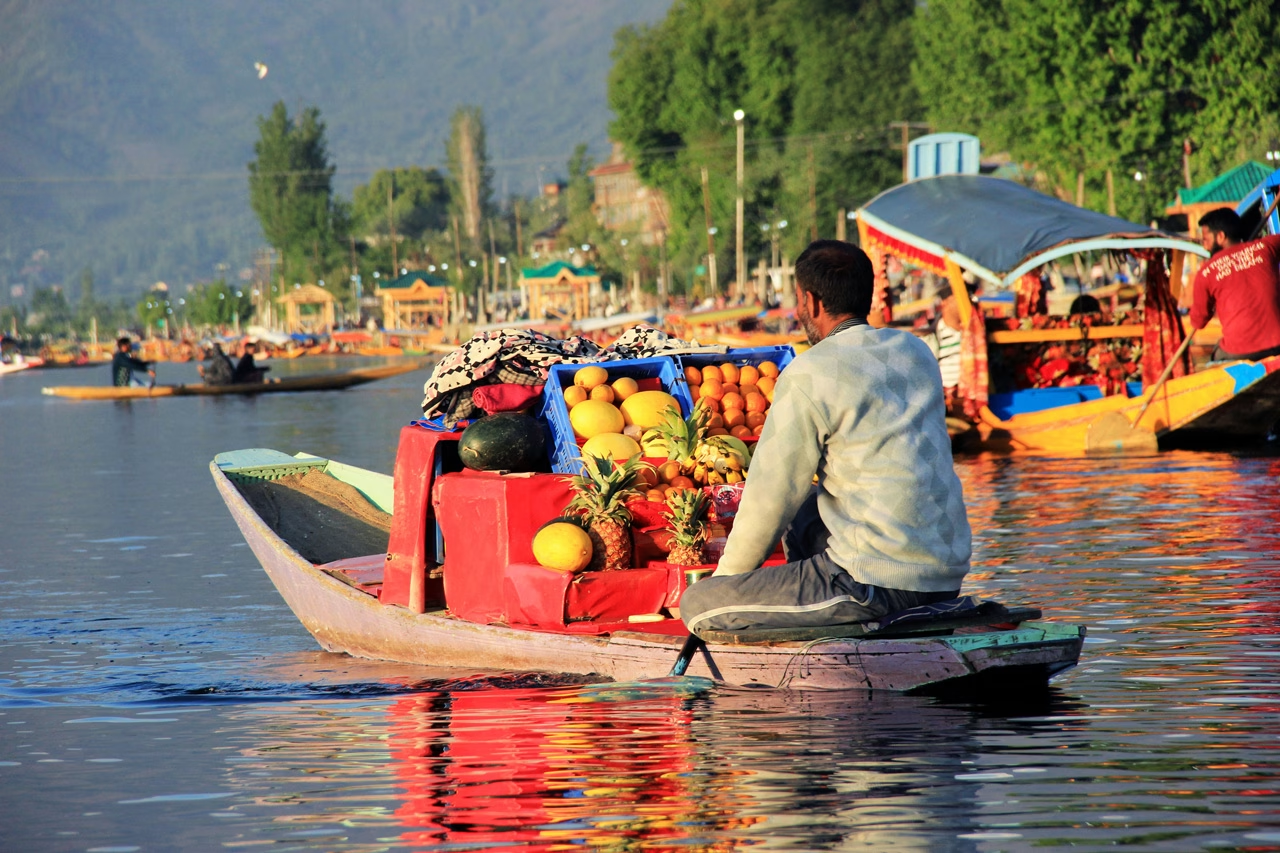
Dist: 201 km | Altitude: 2757m to 3527 m to 1582 m
As you leave, take with you the peace of the mountains and the warmth of the people you met along the way. The breathtaking landscapes, quiet monasteries, and starry skies of Ladakh will stay in your heart forever.
Meals: Breakfast Night: Nil
Location | Places to visit |
Leh | Hall of the fame War memorial, Shey Monastery, Thiksey Monastery, Shanti Stupa, Leh Palace, Leh Market, Gurudwara Patthar Sahib, Magnetic Hill, Rafting Point. |
Nubra | Khardung La, Diskit Village, Diskit Monastery, Sand Dunes, Camel Ride Point, Hunder, Shyok River. |
Turtuk | Turtuk |
Pangong Tso | Shayok, Durbuk, Tangsay Village, Pangong Lake, Chang la Pass. |
Tso Moriri | TsoKar Lake, Puga Hot Spring, Puga Village, Tanglangla Pass |
Kargil | Spituk Monastery, Gurudwara, Magnetic Hill, Sangam, Rafting Point (summers) |
Note:
Hotels and Stays
Leh
Semi Deluxe | Borgo Villa, Jeevanam Villa |
Deluxe | Nature’s Land, Hotel Lalingkha, Hotel Bluestone, Mahey Retreat, Maple Ladakh |
Super Deluxe | Himalayan Retreat Karzoo, Hotel Spa, Charu Palace, The Kaal |
Nubra
Semi Deluxe | Nubra Boutique Camp, Royal Mount, Pika Camp, Weeping Willow Camp |
Deluxe | Paramount Camp, Ladakh Elysium Camp, Urth Home Boutique |
Super Deluxe | Paramount Super Deluxe, Urth Home Boutique |
Pangong
Semi Deluxe | White Heaven Cottage, Mystic Mountain Cottage, Native Retreat Cottage |
Deluxe | Zamta View Point, Native Retreat Cottage, Star Sherathon Cottage |
Super Deluxe | Snowpine Wooden Cottage, Gongma Residency, Polarise Cottage |
Tso Moriri
Semi Deluxe | Tsomoriri Guest House, Tsomoriri Inn |
Deluxe | Tsomoriri Guest House, Tsomoriri Inn, Tsomoriri Guest House, Dorjay Khangsar, Yumchen Cottage |
Super Deluxe | Grand Dolphine, Wisdom House |
Kargil
Semi Deluxe | Jan Palace, Hotel Jazeera Hangout, Hotel Greenland |
Deluxe | Hotel Rangyul, Hotel Siachen |
Super Deluxe | Royal Gasho, Zojila Residency |
We understand that plans can change, but the booking amount is non-refundable due to the costs we incur in preparing for your tour or activity. If you wish to reschedule for a different date, we'll adjust it to the same package, providing you with the necessary flexibility.
If you have paid the total amount but canceled the package. You will be provided with a refund, as mentioned below:
Tours or activities may be canceled due to unforeseen events beyond our control, weather conditions such as heavy rain or storms, or government restrictions like sudden closures of specific areas. In such a scenario, we will provide an alternate tour or activity. However, no refunds will be provided.
Leh:
Leh is a town in the Indian Union territory of Ladakh, serving as the administrative capital of the Leh district. Located at 3,524 meters above sea level, Leh is surrounded by the Himalayas, Karakoram, and Ladakh ranges. It is renowned for its scenic landscapes, historical sites such as the Leh Palace and Tsemo Gompa, and numerous Buddhist monasteries. The district is known for its high-altitude deserts, mountain ranges, and attractions like Pangong Tso, Nubra Valley, and Khardung La Pass. Leh is a popular tourist destination offering activities such as trekking, mountain biking, rock climbing, rafting, and mountaineering. The town also hosts festivals like the Ladakh Festival, the Hemis Festival, and the Ladakh Marathon, which are celebrated for their rich cultural and natural beauty.
Kargil:
Kargil is the second-largest town in Ladakh, situated 205 km from Srinagar. It is known for its Buddhist culture and spectacular views of the Himalayan and Karakoram mountain ranges. The city is on the banks of the Suru River and is close to the Zoji La and Pensi La passes.
Kargil features numerous monasteries and historical sites, including Mulbekh Gompa and Nimmu Monastery, and is famous for its local cuisine, such as thukpa, momos, and dumplings. The town has a significant Shia Muslim population and a notable Buddhist presence in the Dras Valley. Kargil is a gateway to the Zanskar Valley and offers trekking routes like the Markha Valley Trek and Chadar Trek.
Kargil became a separate district in 1979 and, from October 31, 2019, was part of Ladakh’s newly formed Union Territory. The Ladakh Autonomous Hill Development Council Kargil, established in 2003, administers the district, which is divided into nine administrative blocks.
Nubra Valley:
Nubra Valley, located in the Indian Union Territory of Ladakh, is a high-altitude cold desert around 150 km north of Leh. Positioned between the Karakoram and Ladakh mountain ranges at an average altitude of about 10,000 feet, the Nubra (or Siachen) and Shyok Rivers form the valley. It is renowned for its scenic beauty, including dunes, double-humped Bactrian camels, hot springs at Panamik, and ancient Buddhist monasteries. The valley is also known for its apricot orchards, stunning lakes and a significant trade centre for horticultural crops and woollen textiles. Historically, Nubra was a major stopover on the ancient Silk Route and was initially called Ldumra, meaning “valley of flowers.”
Pangong Tso:
Pangong Tso, or Pangong Lake, is a high-altitude lake in Ladakh, India, at 4,350 meters (14,270 feet). The lake spans an area of 604 square kilometres and extends 134 kilometres in length. It is shallow, with a maximum depth of about 30 meters (98 feet), and is known for its stunning deep blue colour and the surrounding snow-capped mountains. Pangong Tso is partially frozen during the winter despite being saline, with the ice breaking up in late May or early June. The lake is a breeding ground for various bird species and is home to wildlife such as marmots and kiangs. It is one of the largest saltwater lakes in the world.
Turtuk:
Turtuk is a village in the Ladakh of Leh district, India, in the Nubra Valley alongside the Shyok River. It is the northernmost village in India before the border with Pakistan. It is known for its unique Balti culture, being one of the few places in India where Balti people reside. The village is renowned for its apricots and stunning views of the Shyok Valley. Turtuk features several gompas and an old royal residence, and it started attracting tourists in 2010. It is a significant stop for trekkers and travellers interested in experiencing the local culture.
Tso Moriri:
Tso Moriri, also known as Lake Moriri, is a high-altitude lake on the Changthang plateau in southeastern Ladakh, India, at about 15,075 feet (4,587 meters). It is the highest saline lake in India and is accessible only during the summer months. Fed by streams from the north and southwest, swamps surround the lake and have become saline because it is landlocked, with its southern outlet having dried up. Historically, locals extracted salt from the lake until 1959. The lake’s water, which is alkaline and oligotrophic, supports various nutrient-rich microorganisms. Tso Moriri is classified as a remnant lake, indicating that it was once part of a much larger body of water and part of Tso Moriri Wetland Conservation Reserve, underscoring its ecological significance.
Best time to visit Ladakh
The prime time to explore Leh Ladakh is between May and September, when the weather is mild and perfect. This period allows access to the region’s spectacular scenery, including Nubra Valley and Pangong Lake, and provides excellent opportunities for sightseeing. Since June to August is the high tourist season, it’s advisable to plan your trip to avoid the rush and find better rates for lodging. Ensure you stay updated on weather forecasts.
| Travel Months | Min/Max Temperature | Season |
| April to June | 15° C to 30° C | Summer |
| July to Sep | 3° C to 17° C | Monsoon |
| Oct to March | 0° C to 15° C | Winter |
Traditional Dresses of Ladakh
Ladakhi dress: Goncha and Sulma
The traditional Ladakhi dress comprises two main pieces: the Goncha and the Sulma. The Goncha is a long, robe-like garment made of heavy wool, typically in black, brown, or grey, and is fastened at the waist with a belt. Over the Goncha, individuals wear the Sulma, a long coat with distinctive patterns such as stripes or diamonds, often in bright colours and made from wool, cotton, or silk. Both men and women wear these garments, with variations in colours and patterns based on region and gender. Additional items such as scarves, hats, and boots may be included, and accessories like jewellery, decorative scarves, and embroidered bags can also be part of the traditional attire. This dress is a crucial element of Ladakhi culture, reflecting their identity and heritage.
Changpa nomads dress: Kos Kar
The traditional clothing of Changpa nomads, known as “Kos Kar,” is a long, loose-fitting robe with a high collar, long sleeves, and front buttons. Made from thick wool, it often features intricate embroidery and various colours. The Changpa headwear is a cylindrical, brightly coloured hat called a “Tupa,” also made of wool. Additional accessories may include jewellery, sashes, and scarves. Changpa nomads live in the high-altitude regions of India, Bhutan, and Tibet. Their clothing is designed for durability and protection against the harsh Himalayan climate. The Changpa are also known for their vibrant, handmade wool rugs, which are integral to their traditional attire.
Ladakhi headdress: Perak
The Ladakhi headdress, known as the perak, is typically worn by men and is made of thick cotton or wool, decorated with embroidery and tassels. It is conical in shape and often brightly coloured. The perak is also worn by monks and lamas of the Gelugpa school of Tibetan Buddhism. It is traditionally paired with a long, brightly coloured, and intricately embroidered silk scarf, a khaddar, draped over the shoulder. The perak and khaddar combination symbolises respect and devotion, reflecting traditional Ladakhi culture and heritage.
Ladakhi headdress worn by Muslims: Jugin
The Jugin is a traditional Ladakhi headdress worn by Muslims in Ladakh. It is made from vibrant, colourful fabric and decorated with intricate embroidery and accents. It is typically worn on special occasions like weddings and festivals. The Jugin is an essential symbol of pride, strength, and resilience in Ladakhi culture and is often passed down through generations. It is usually paired with a long flowing skirt and a bright-coloured scarf, reflecting its significance in Ladakhi identity and heritage.
Drokpa headdress: Tepi
The Drokpa headdress is a traditional hat worn by the Drokpa people of the Himalayan region. It features a heart-shaped crown with a large brim and is made of felt decorated with colourful beads and sequins. Men and women wear headdresses, often with a bright scarf and head ornament. Known as ‘Tepi’ in Drokpa, it symbolises respect, honour, and social status. The Drokpa headdress remains a distinctive and meaningful part of traditional clothing, reflecting the pride and cultural heritage of the Drokpa people.
Zanskari cap: Serpo Tipi
The Serpo Tipi is a traditional Zanskari cap worn in Ladakh, India. It is a dome-shaped hat made of felt or wool, typically in black or grey, and may be decorated with embroidery or beadwork. The cap is worn by both men and women as part of traditional attire, often with a black or grey gown or robe known as a ‘chuba’. The Serpo Tipi is believed to ward off evil spirits and bring good health. It plays a vital role in Zanskari culture and is commonly seen during traditional festivals, gatherings, and special occasions like weddings.
Cape: Yogar and Lokpa
Yogar and Lokpa are traditional villages in Ladakh, India, known for their stunning mountain views, ancient Buddhist monasteries, and unique culture. Connected by a narrow winding road, these villages offer insight into traditional Ladakhi life, including farming practices and cultural experiences. Visitors can explore monasteries, enjoy natural landscapes, and participate in hiking, cycling, horse riding, and mountaineering activities. The region is also known for its traditional festivals like Losar and Hemis, and visitors can experience Ladakhi cuisine and local handicrafts.
Ladakhi shoes: Pabu
Ladakhi shoes, or Pabu, are traditional footwear made from hand-stitched goatskin leather. They are designed to keep feet warm in Ladakh’s harsh climate and are typically dyed bright red or blue, sometimes with embroidery. The Pabu is worn with traditional Ladakhi clothing, such as the go and kurta, and is a vital part of Ladakhi culture and identity. It is often seen in festivals and celebrations. The Pabu is durable and practical for everyday wear, though it can be expensive and requires proper care to maintain longevity.
Ladakhi amulet: Kau
A Ladakhi amulet is a talisman worn for luck, prosperity, and protection, typically made of stones and metals. It often features symbols such as the sun, moon, stars, swastika, and the eight-spoked wheel, believed to attract positive energy. The Kau is a significant symbol in Ladakhi culture, a four-pronged swastika representing the four elements (earth, water, air, fire), directions, seasons, and stages of life. Worn on the neck or wrist, the Kau amulet is thought to provide protection, strength, and good fortune to its wearer.
Ladakhi hat: Tipi
A Ladakhi hat is a traditional headwear from the Indian Himalayas, typically made of wool and shaped like a tent or tipi. It often features colourful geometric embroidery on the top and bright fabric lining on the sides. The hat, worn with a scarf or shawl, protects from the cold and sun and symbolises Ladakhi identity. It is an integral part of traditional dress for both men and women and is sometimes worn by tourists to show respect for the culture. The hat is a practical and stylish accessory, reflecting Ladakhi cultural heritage and offering protection in the region’s harsh weather.
Designer clothes (Jigmat Couture, Namza Couture, Zilzom)
Jigmat Couture, Namza Couture, and Zilzom are luxury fashion labels in Ladakh.
Jigmat Couture: Known for sophisticated designs blending traditional Ladakhi and Tibetan elements with modern touches, featuring intricate embroidery, luxurious fabrics, and classic silhouettes.
Namza Couture focuses on high-end designer clothing that combines traditional Ladakhi and Tibetan designs with contemporary fashion trends. It uses high-quality fabrics and exquisite details.
Zilzom offers bold and exotic designs inspired by traditional Ladakhi, Tibetan culture, and modern trends. These pieces feature bright colours, intricate embroidery, and luxe fabrics. Custom-made pieces are also available.
Festivals of Ladakh
Sindhu Darshan is a festival celebrated in Ladakh, India, to honour the Indus River (Sindhu River). It occurs annually on the full moon day of the Hindu month of Shravan (July-August). Devotees and pilgrims visit Ladakh to pay homage to the river, participating in grand processions with floats carrying images of Lord Shiva, Goddess Parvati, and the Trishul (trident). The festival features cultural performances, musical concerts, traditional songs and dances, and an exhibition of Ladakhi handicrafts and artefacts. It offers a chance to explore Ladakh’s ancient monasteries, holy shrines, and stunning landscapes, providing insight into local culture and traditions.
Losar Festival
The Losar Festival, also known as the Tibetan New Year, is a significant festival celebrated in Ladakh, India, during the 11th month of the Tibetan calendar. The 15-day festival involves traditional customs and rituals. Key events include:
First Day: Lighting butter lamps and performing the Chaam dance to ward off evil spirits.
Second Day: Preparing unique dishes and making offerings to the gods.
Third-Day: Performing the Gutor ritual for good luck and prosperity.
Fourth Day: The Losar Tashi Delek ritual involves greetings and exchanges.
Fifth Day: Celebrating at monasteries with traditional dances.
Sixth Day: Commemorating the King’s coronation and enjoying the Losar feast.
The Hemis Festival, held annually at Hemis Monastery in Ladakh, celebrates the birth of Guru Padmasambhava, the founder of Tibetan Buddhism. Key features of the festival include:
Giant Thangka: The ceremonial unfurling of a large thangka (a painting of Guru Padmasambhava).
Celebrations: A two-day event featuring masked dances, music, and cultural activities.
Traditional Handicrafts: Opportunities to purchase local handicrafts and enjoy Ladakhi cuisine.
Leh, in Ladakh, India, is renowned for its breathtaking mountain landscapes, ancient Buddhist monasteries (such as Thiksey, Hemis, Shey, and Stakna), and historic forts. It's a gateway for trekking in the Himalayas and is famous for adventure activities like river rafting and paragliding. Leh also features unique local cuisine (like momos and thukpa) and vibrant cultural experiences, including traditional festivals and dances. The annual Ladakh Festival attracts global tourists, making Leh a prominent destination for adventure seekers and cultural enthusiasts.
Nubra Valley, known for its views of the Karakoram mountain range, features a unique landscape of dunes, snow-capped mountains, and lush greenery. It hosts the world's highest motorable road, Khardung La Pass, and is famous for its Buddhist monasteries, including Diskit Monastery. The valley is a hub for outdoor activities like trekking and camping, and its cultural heritage blends Tibetan, Indian, and Ladakhi influences. Festivals like the Nubra and Sand Dune Festivals celebrate their vibrant local culture and traditions.
Tso Moriri Lake in Ladakh is renowned for its stunning beauty, diverse wildlife, and peaceful setting. Surrounded by mountains, its clear waters offer breathtaking views, often considered more beautiful than Pangong Lake. The area is home to unique wildlife, including the Bar-headed geese, and its remote location ensures tranquillity, with spectacular sunsets adding to its charm. It's also the largest high-altitude lake entirely within India.
Kargil is renowned for the 1999 Kargil War, a significant conflict between India and Pakistan. It is noted for its stunning mountain scenery and strategic location, making it popular with trekkers and mountaineers. Kargil is a gateway to Ladakh situated at 2,676 meters (8,780 feet). The town is known for its traditional culture, including ancient monuments, temples, mosques, and local cuisine, such as Kargil Pulao.
Pangong Lake, located in the Himalayas between India and China, is renowned for its stunning beauty and unique geographical features. It is the highest saltwater lake in the world, with half of it in India and the other half in China. The lake's colour changes from deep blue to light green depending on the weather, and it is a popular spot for its picturesque landscapes and stargazing opportunities. It also hosts various migratory birds, including Brahminy Ducks and Bar-headed Geese.
China partially occupies Pangong Lake. The lake extends into India and China, with about two-thirds of it lying in Chinese territory and the remaining one-third in India. The Line of Actual Control (LAC) marks the boundary between Indian and Chinese areas around the lake.
Visiting Pangong Lake in one day is not feasible. The lake is about 163 km from Leh, requiring 6-7 hours of travel. The route is scenic but challenging, making it advisable to plan for at least two days to enjoy the trip thoroughly. Consider adding activities like camping or exploring local villages to enhance your visit.
For an optimal experience, plan your visit to Pangong Lake from May to September. When the weather is moderate, the lake is accessible for camping and boating. Visiting from October to April is possible but can be very cold, with the lake often frozen. Always bring warm clothing and be prepared for high-altitude conditions. Respect local regulations and avoid activities that might harm the environment.
Pangong Lake is known for its deep blue waters and breathtaking mountain views, offering a peaceful setting. Nubra Valley is Well-known for its dunes, Bactrian camels, and Buddhist monasteries, offering a distinctive and adventurous experience. The choice between them depends on whether you prefer serene landscapes or unique activities like camel rides in the dunes.
Due to security reasons, overnight stays directly at Pangong Lake are not permitted. However, nearby Tangste, Merak, Spangmik, Man, and Lukung campsites offer basic accommodation and amenities. Booking is required for these campsites.
Yes, staying overnight at Pangong Lake is advisable to fully experience its beauty. You can choose from camping sites or nearby hotels. Prepare for freezing weather and bring warm clothing, food, and water. Activities include trekking, bird watching, and jeep safaris. Check weather forecasts, travel restrictions, and travel advisories before your trip.
Pangong Lake is a high-altitude lake at over 4,350 m (14,270 ft). It is located in the Ladakh region of the Himalayas, partially in India and partially in China. Due to its high altitude, the water temperature is very low, and the lake is frozen for most of the year. Therefore, bathing in Pangong Lake is not possible. The lake is also a protected area and home to many rare species of birds and other wildlife. Thus, swimming and other activities that could potentially disturb wildlife are prohibited.
No, there is no internet access at Pangong Lake. The lake is located in a remote area of the Himalayas, and there is no infrastructure for Internet access. However, if you are travelling to Pangong Lake, you can find internet access in nearby towns and cities.
Pangong Lake is located in the remote area of Ladakh in India and has no mobile coverage. Therefore, no SIM card will work at the lake. Major mobile networks like Airtel, Jio, and BSNL are available in the region. Please note that phone signals may need to be more robust or present in some lake areas due to their remote location.
Yes, you can see the Milky Way from Pangong Lake. The high altitude and clear, dark skies of Pangong Lake provide excellent conditions for stargazing. The minimal light pollution in this remote area enhances the visibility of celestial objects, making it a fantastic spot for observing the Milky Way and other stars.
Turtuk is a small village in the Nubra Valley of Ladakh, India. It is famous for its Balti culture, a mixture of Tibetan, Central Asian, and Indian cultures. The village is also known for its local apricot orchards and stunning views of the Karakoram mountain range.
Turtuk village in the Shyok Valley of Ladakh is the last Indian village on the Indo-Pakistan border. Surrounded by the Karakoram Range, it offers stunning mountain views and insights into the Balti culture. Activities include trekking, mountain biking, and camping, and it is home to some of the oldest Buddhist monasteries in the region.
No, K2 is not visible from Turtuk. K2, the world's second-highest mountain, is in Pakistan's Karakoram Range. In contrast, Turtuk is a village in the Union Territory of Ladakh, India. A distance of approximately 614 km separates the two locations, and the mountain is on the other side of the India-Pakistan border. Therefore, it is not possible to see K2 from Turtuk.
In Turtuk village, you can buy traditional items such as hand-woven shawls, hand-knitted caps, jewellery, leather goods, traditional dresses, and souvenirs. Local products include dried fruits, nuts, wool, carpets, handicrafts, and pottery. You can also enjoy traditional Balti cuisines like Phaag, Cholak, and Gushtaba.
Leh is the largest town in Ladakh, a mountainous region in the western Himalayas. Ladakh encompasses a large geographical area, including several valleys and regions, such as Nubra Valley, Zanskar Valley, Markha Valley, and Indus Valley. Leh is known for its cultural heritage, Tibetan Buddhist monasteries, and popularity as a trekking destination, while Ladakh features diverse landscapes and cultures across its broader region.
Tso Moriri is a high-altitude lake in the Changthang Plateau of Ladakh, India, known for its serene beauty, blue-green colour, and reflection of surrounding mountains. It is a popular spot for trekkers, photographers, and stargazing and holds spiritual significance for Buddhists and local tribes. The lake is part of a wetland conservation area and is home to migratory birds and endangered species. Its stunning sunsets and sunrises and role as a filming location have increased its popularity among tourists.
Tso Moriri is known for its serene beauty and is ideal for trekking, camping, and bird-watching, offering a peaceful experience. Pangong Lake stretches into Tibet and is renowned for its stunning beauty. It is an excellent spot for photography and adventure. Choosing between them depends on whether you prefer tranquillity (Tso Moriri) or adventurous photography opportunities (Pangong).
Tso Moriri Lake in Ladakh is renowned for its stunning beauty, diverse wildlife, and peaceful setting. Surrounded by mountains, its clear waters offer breathtaking views, often considered more beautiful than Pangong Lake. The area is home to unique wildlife, including the Bar-headed geese, and its remote location ensures tranquillity, with spectacular sunsets adding to its charm. It's also the largest high-altitude lake entirely within India.
Yes, Tso Moriri is a freshwater lake in Ladakh, India. It is situated in the Changthang Plateau at an altitude of 4,522 m (14,836 ft). It is one of the largest high-altitude lakes in India and is a Ramsar site.
The road from Leh to Tso Moriri takes about 4-5 hours and is mainly paved but can be treacherous due to high elevation and sharp turns. It offers spectacular mountain views, but frequent stops for acclimatisation are recommended. The road may be affected by snow and landslides, so checking conditions before travel is essential.
The road from Pangong to Tso Moriri is rough, unpaved, and challenging. It has steep inclines and declines and is prone to landslides and rockfalls. It is unsuitable for low-ground clearance vehicles and can be dangerous in bad weather. Despite its difficulty, the road offers breathtaking views of the Himalayas. You should hire a local driver and travel with a support vehicle or in a convoy.
A permit issued by the Indian Army is required for Tso Moriri, which is necessary for trekking and camping in the Tso Moriri Wildlife Sanctuary. It can be obtained through the District Tourism Office of Leh or a registered travel agency. Foreign nationals must register at the Foreigners Regional Registration Office (FRRO) in Delhi or Leh before applying. The permit is valid for seven days and must be renewed if the stay is extended.
Tso Moriri, a high-altitude lake in Ladakh, India, situated at 4,522 meters (14,836 feet), does not freeze.
Tso Moriri, or "Mountain Lake," is located in the Changthang Plateau in the Leh district of Ladakh, India.
Tso Moriri, also known as “Mountain Lake,” is the highest lake in Ladakh, located at 4,522 meters (14,836 feet) in the Changthang region. The lake supports diverse wildlife, including snow leopards and migratory birds, and is protected as a Ramsar wetland. It is sacred to the local Changpa people and offers activities.
Tourists are allowed in Kargil with the appropriate permits from local authorities. Some areas may be restricted due to military control, and visitors should be cautious of the potentially volatile security situation.
Kargil War Memorial
Suru Valley
Moonland
Mulbekh Monastery
Goma Kargil
War Museum
Suru River
The road from Leh to Kargil, taking about 8-9 hours, is long and winding but generally in good condition. It offers stunning views of snow-capped mountains, deep gorges, and green valleys, with the highest elevation at Fotu La (13,479 feet). Frequent breaks are recommended to prevent altitude sickness. The route is prone to landslides and avalanches, so checking weather and road conditions is essential, and driving at night is not advised due to wildlife risks.
Ladakh's culture blends Tibetan, Indian, and Central Asian influences, with Tibetan Buddhism playing a central role. The traditional dress and language, Ladakhi, are similar to Tibetan traditions. Ladakhi cuisine combines these diverse influences, and traditional architecture features Tibetan styles with mud brick and stone. The region is known for festivals like the Hemis and Ladakh Festivals, stunning landscapes, and diverse ethnic groups, including Ladakhis, Baltis, Tibetans, and Zanskaris. Ladakhis comprise about 90% of the population, contributing significantly to the region's cultural identity.
Ladakh is celebrated for its unique cultural heritage, featuring a blend of Tibetan, Indian, and Central Asian influences. Its traditional architecture, arts, music, religion, and vibrant festivals reflect its rich spiritual heritage, with numerous monasteries and breathtaking landscapes, including mountains, valleys, and lakes. The region's cultural diversity is enriched by various ethnic groups, such as Ladakhis, Tibetans, Baltis, and Kashmiris, and religions like Buddhism, Hinduism, and Islam, making it a significant cultural heritage site in India.
Ladakhi food is influenced by its geography and includes staples like barley, buckwheat, millet, Tsampa (roasted barley flour), Pulao (rice), Thukpa (noodle soup), and Momos (dumplings), along with dairy products. The culture, shaped by Tibetan Buddhist heritage, features reverence for nature, essential monasteries, and festivals such as Losar (Tibetan New Year) and Hemis. Traditional folk music, dance, Thangka paintings, and jewellery making are also integral to Ladakhi culture.
Ladakh's lifestyle is shaped by its rugged landscape and unique culture, with people living in remote villages and practising Buddhism. Their traditional lifestyle revolves around agriculture (barley, potatoes, vegetables), animal husbandry, trading, and tourism. Polyandry, where a woman marries multiple brothers, is practised in some villages. Ladakhis are known for hospitality, vibrant festivals, and traditional music and dance. Modern technology slowly integrates into their lives, but traditional culture remains strong. Ladakhi cuisine features local ingredients and traditional cooking methods, while handicrafts include pottery, weaving, and jewellery. Trekking, mountaineering, and cultural experiences attract visitors to this region.
Traditional Ladakhi art, characterised by vibrant colours, includes mural painting, wood carving, weaving, applique work, paper mache, and metalwork. Influenced by Tibetan art, these centuries-old art forms are vital to local identity and culture. They decorate homes, shrines, and monasteries and provide a source of income for local artisans who sell their work to tourists.
Ladakh's rich cultural heritage blends Tibetan, Hindu, and Islamic influences. It features ancient monasteries, traditional festivals, and distinctive art forms. The cuisine, influenced by Tibetan, Central Asian, and Kashmiri traditions, includes dishes like thukpa (noodle soup), momos (dumplings), and tsampa (roasted barley flour). Ladakh's culture remains vibrant with traditional practices, including Tibetan Buddhism and traditional dress, reflecting influences from neighbouring regions like Tibet, Mongolia, and Central Asia.
Ladakh's heritage comprises:
1 . Archaeological Heritage: Includes ancient monasteries, monuments, palaces, forts, stupas, and chortens built by Ladakh's rulers.
Ladakh is renowned for its spectacular mountains, unique culture, and Buddhist monasteries. It is known as the “Land of High Passes” and features some of the highest altitudes in the world, including Khardung La, the highest motorable pass. The region offers adventure activities like trekking, mountain biking, and rafting and is home to wildlife such as snow leopards and Tibetan wolves. Its rich cultural heritage includes traditional music, dance, art, and unique cuisine like thukpa, momos, and tsampa.
The most well-known architecture of Ladakh is the Ladakhi style of Tibetan Buddhist architecture, which includes white-washed stupas, monasteries, and palaces built from mud, brick, and wood. Examples of this type of architecture are the Shey Monastery, Thiksey Monastery, and Hemis Monastery.
The prominent heritage buildings in Ladakh include:
Leh Palace
Alchi Monastery.
Shey Palace
Hemis Monastery
Thikse Monastery
Stok Palace
Phyang Monastery
In Ladakh, traditional houses are built with mud bricks and wood, often featuring whitewashed walls, slate roofs, and vibrant colours with intricate wood carvings. These multi-storied homes typically include a central courtyard. There is also a unique structure called a "Chorten," used as shelters, meditation spaces, or places of worship, characterised by its round or rectangular shape and lack of windows. Modern houses in Ladakh are increasingly built with concrete and stone, and eco-friendly homes using compressed earth blocks, straw bales, and recycled materials are becoming more common.
| # | Discount group | From adult | To adult | Value |
|---|---|---|---|---|
| 1 | Discount (3 to 4 person) | 3 | 4 | 5% |
| 2 | Discount (5 to 6 person) | 5 | 6 | 15% |
| 3 | Discount (7 to 8 person) | 7 | 8 | 20% |
| 4 | Discount (8 to 9 person) | 8 | 9 | 25% |
| 5 | Discount (9 to 10 person) | 9 | 10 | 30% |
| 6 | More than 10 | 10 | 50 | 35% |
Leave a review